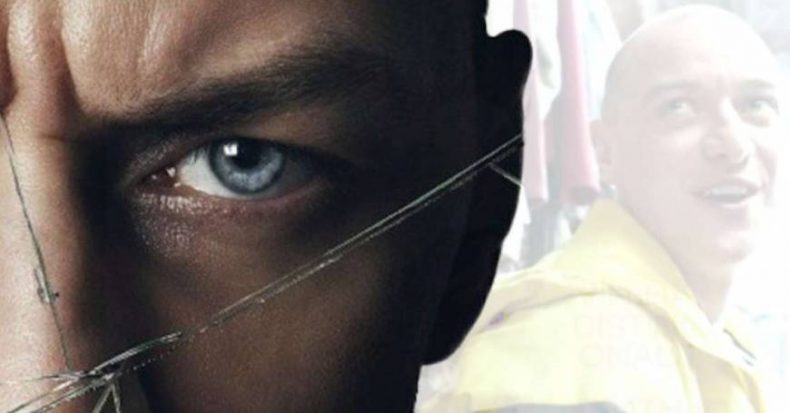It probably came as a surprise to most of us that “Split” was as good as it was. After M. Night Shyamalan directed two of the best movies I’ve ever seen, the ghost horror “The Sixth Sense” and the superhero-themed “Unbreakable”, he proceeded to place his name on an entire series of what are truly, awful, awful films, ranging from “Okay, yeah, this is pretty bad” to “HOW COULD ANYONE POSSIBLY THINK THIS WAS A GOOD IDEA” in terms of quality. While critics loved 2015’s “The Visit”, calling it a return to norm for Shyamalan, I, much like most of the audience, thought that it was almost as bad as the movies that came before it. And then, out of nowhere, this director that everyone thought of as a two-trick pony comes out and surprises us with what is an undoubtedly the best January movie in recent memory. And while “Split”, starring young Professor X and Morgan, was a competently made film about a guy with multiple split personalities, I have to admit that a good part of the reason why it was so good and why it’s currently being received so well by audiences and critics is because of its twist ending. So instead of being like every other site and asking “WHAT DOES THAT MEAN FOR SHYAMALAN’S FUTURE?!”, let’s take a moment and ask the more interesting question – why does that twist work so well?
In order to reach a proper answer, we’re going to look through Shyamalan’s career and examine the various twists, see why they work and why they don’t, and also discuss what exactly makes for a good plot twist. It goes without saying that from this point on there will be MAJOR spoilers for not only “Split”, but for almost all of Shyamalan’s movies. This is your warning! Don’t scroll past the crazy James McAvoy if you care!
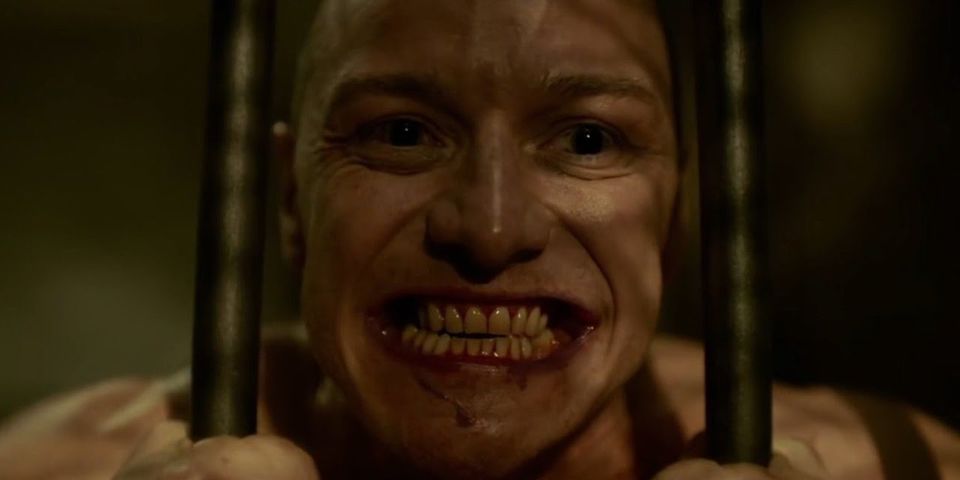
Still with us? Okay, good. First, let’s get the obvious out of the way and talk a little bit about “Split”, just so we can have some context and a baseline. “Split” tells the story of a man named Kevin, played by James McAvoy, who has 23 split personalities within his head. One of them decides to abduct three teenage girls and imprison them in a basement, so that they could be used to “feed” a mysterious 24th personality known as the Beast. A psychologist, played by Betty Buckley, has been studying Kevin in the hopes of proving her theory that the different personalities can have a drastically different effect on the human body they inhabit (for example, one of Kevin’s personalities is a diabetic girl who requires insulin, and in another, unrelated case three of a blind woman’s personalities could see). She believes that the Beast isn’t actually real, but rather a personification of the darker recesses of his subconscious. The psychologist realizes that Kevin has abducted the girls, goes to save them, and that’s when we get our first big twist – the Beast is real, and he literally eats two of the girls in order to sustain himself. From that point onward, Kevin’s body continues to mutate as he starts climbing on walls, surviving point-blank shotgun blasts and just reaching an all-new level of superhuman because of his new personality. Finally, he realizes that one of the girls he kidnapped, played by Anya Taylor-Joy, shares a similar past with him and decides to leave her alone, running off into the night. The girl escapes, tells the police everything, and the news name Kevin a wanted killer and dub him “The Horde”.
And if that sounds like the absolute craziest, over the top, most terrible excuse for a horror movie, then you’d be completely right. It makes no sense. The explanation for Kevin’s abilities goes way past pseudo-science and into “Come oooon, are you serious” territory. It falls right there with an irradiated spider biting a kid and giving him spider-powers, or a bomb explosion turning a guy into a huge, indestructible monster whenever he gets angry! Wait a minute… Yep, indeed – the last shot of the movie reveals Bruce Willis as David Dunn watching news coverage about The Horde, revealing that this entire movie was actually a secret sequel to the superhero movie “Unbreakable”. It wasn’t a horror movie at all – it was a supervillain origin story all along. It was supposed to be crazy, over the top and nonsensical, because that’s what comic book origin stories are!
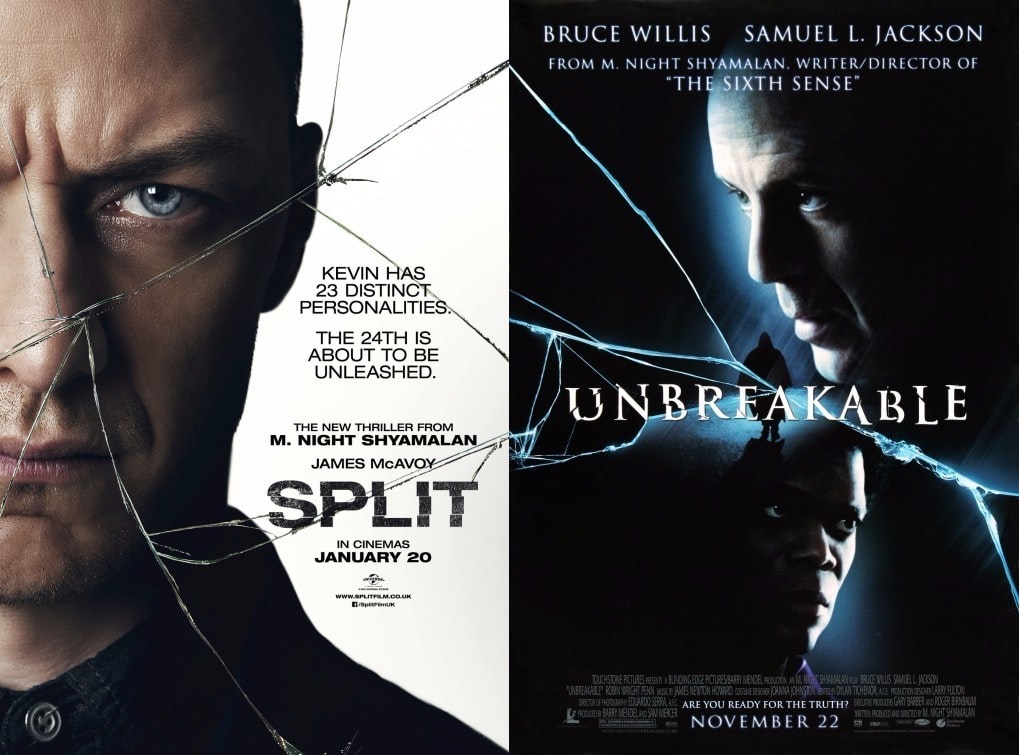
Surprisingly, the posters spoiled the twist way before the movie even came out.
So let’s get back to our original question – why is that twist so good? After all, it’s just connected to a 15 year old movie! What’s the big deal? It’s not just the connection, really. If Shyamalan had revealed that “Split” was set in the same universe as, say, “The Village”, I don’t think anyone would have cared. The twist, however, completely changes the tone of the entire movie, hell, it changes its very genre. Suddenly all of the plot holes make sense, all of the logical fallacies and inconsistencies are explained, all of the things that made you scratch your head put a smile on your face. The twist isn’t just a fun little addition to the story, it makes a second viewing completely different from the first one. And, at the end of the day, that’s what a twist is supposed to do. A good movie twist (or, hell, a good plot twist at the end of anything, be it a book, a videogame or a comic) is supposed to make you reevaluate what you’ve experienced up until this point. The “I am your father” twist from “The Empire Strikes Back” is not only shocking and unexpected, but also changes the entire course of the trilogy, both what has happened before that moment and what happens after it. “A New Hope” and most of “Empire” deal in very black and white themes – Jedi and rebels good, Stormtroopers and Empire bad. But all of a sudden, with one sentence, Darth Vader proved to both the main character and the viewers that things are a whole lot grayer than the seemed. The Jedi, which we’ve thought of as paragons of truth and virtue, were exposed as liars and manipulators, and the greatest villain of the galaxy was once its greatest hero. Despite the fact that the twist most likely wasn’t even conceived when “A New Hope” was made, you can’t watch that movie without raising an eyebrow at Obi-Wan’s deception or reading into the subtext of Vader sensing his son for the very first time.
Shyamalan is no stranger to this knowledge, as he employed it to perfection in his debut movie, “The Sixth Sense”. In that film, Bruce Willis plays a child psychologist struggling with a failing marriage while trying to help a boy that claims to see ghosts. And of course, the twist is just as famous today as the line “I see dead people” – the psychologist was dead all along, and his marriage wasn’t failing, his wife was just grieving for him. It’s a fantastically written and presented twist which completely changes the movie on a second viewing. The themes, the message, the character dynamics, everything is altered by the knowledge that Bruce Willis is dead. That’s exactly what a good plot twist is supposed to do! Unfortunately, for whatever reason Shyamalan completely forgot that fact, and up until “Split” his twists felt forced, uninspired and thrown in for the sake of having a twist.
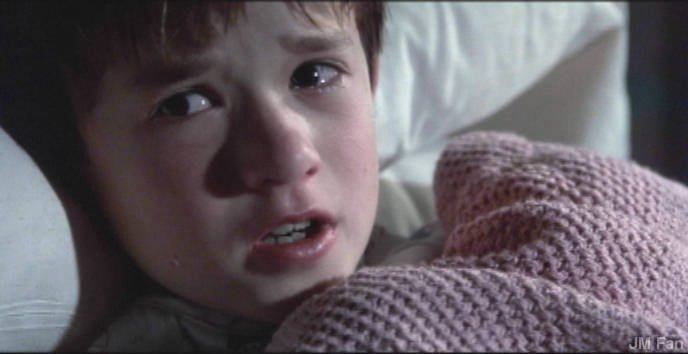
“I see bad plot twists!”
Some of his movies, such as “Signs” or “After Earth”, didn’t even have proper twists, but let’s focus on a couple of films that did and try to determine where they failed. First off – the critical darling known as “The Visit”. In it, two kids go across the country to visit their estranged grandparents, who they’ve never seen before, except uh-oh – Grandma and Grandpa are both insane and terrorize the children for days before eventually hanging a neighbor and trying to kill them. The twist, of course, is that they’re not actually their grandparents, just some crazy people that killed the grandparents and took their place, for some reason. But honestly… What’s the point? What does that change at all? I mean, if you go back and rewatch the movie knowing what’s happening, is the experience different in any way? Would the final showdown have changed at all if it was the kids’ biological grandparents trying to kill them rather than some strangers who were pretending? What is the point of it, other than to have a twist? It wasn’t exactly harmful, but it felt very unnecessary.
What was harmful, however, was the twist of “The Village”. The movie is about a small 18th century village which lives in fear of the monsters that come out of the woods and haunt it every night. There’s actually two twists here – the movie’s set in modern day and the villagers only think it’s the past, and the monsters also aren’t real, they’re just costumed elders aiming to prevent anyone from wandering off and discovering civilization. That twist does exactly what it’s supposed to, as it gives you a brand new way to look at the movie on a rewatch. However, the new way is infinitely inferior to the old one, because it reduces tension and creates plotholes. Why should I care about the characters hiding from the monsters when I know for a fact they’re not in any real danger? How do the monsters move their mouths and make all these guttural sounds when it’s later revealed their faces are nothing but rubber masks? I could go on and on, but when your twist creates more questions than it answers, then it only ends up hurting your movie.
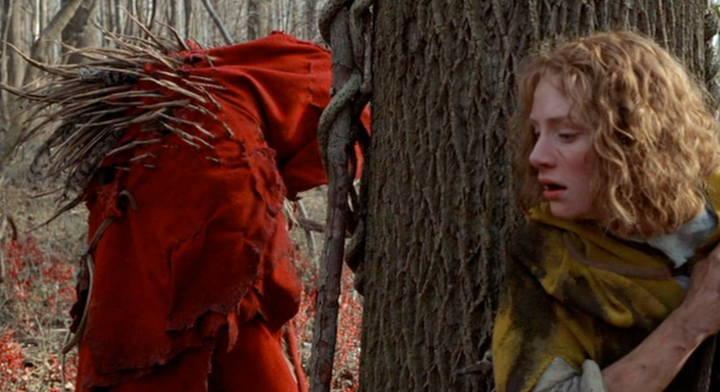
Don’t worry, he’s physically incapable of harming you in that getup.
Surprisingly, “Split” didn’t fall into any of those plotholes. Its twist was necessary. It made sense. It gave context. It was surprising. It did everything that a proper movie twist was supposed to do… Well, almost everything. If you haven’t seen “Unbreakable”, like most of the people in my movie theater apparently hadn’t, you simply aren’t provided with all of the information you need in order to make the connection. This isn’t really the movie’s fault, though, because I genuinely can’t think of a way the twist could have been established better without giving it away much earlier. Sure, some people were disappointed by “Split” because when they bought their tickets they didn’t want a comic book movie, they wanted a horror. And that’s fine, I can understand it, but honestly, I can’t really judge a movie for what I want it to be. All I can judge it for is what it is, and “Split” in particular is a return to norm for M. Night Shyamalan, at least as far as his twists are concerned.

